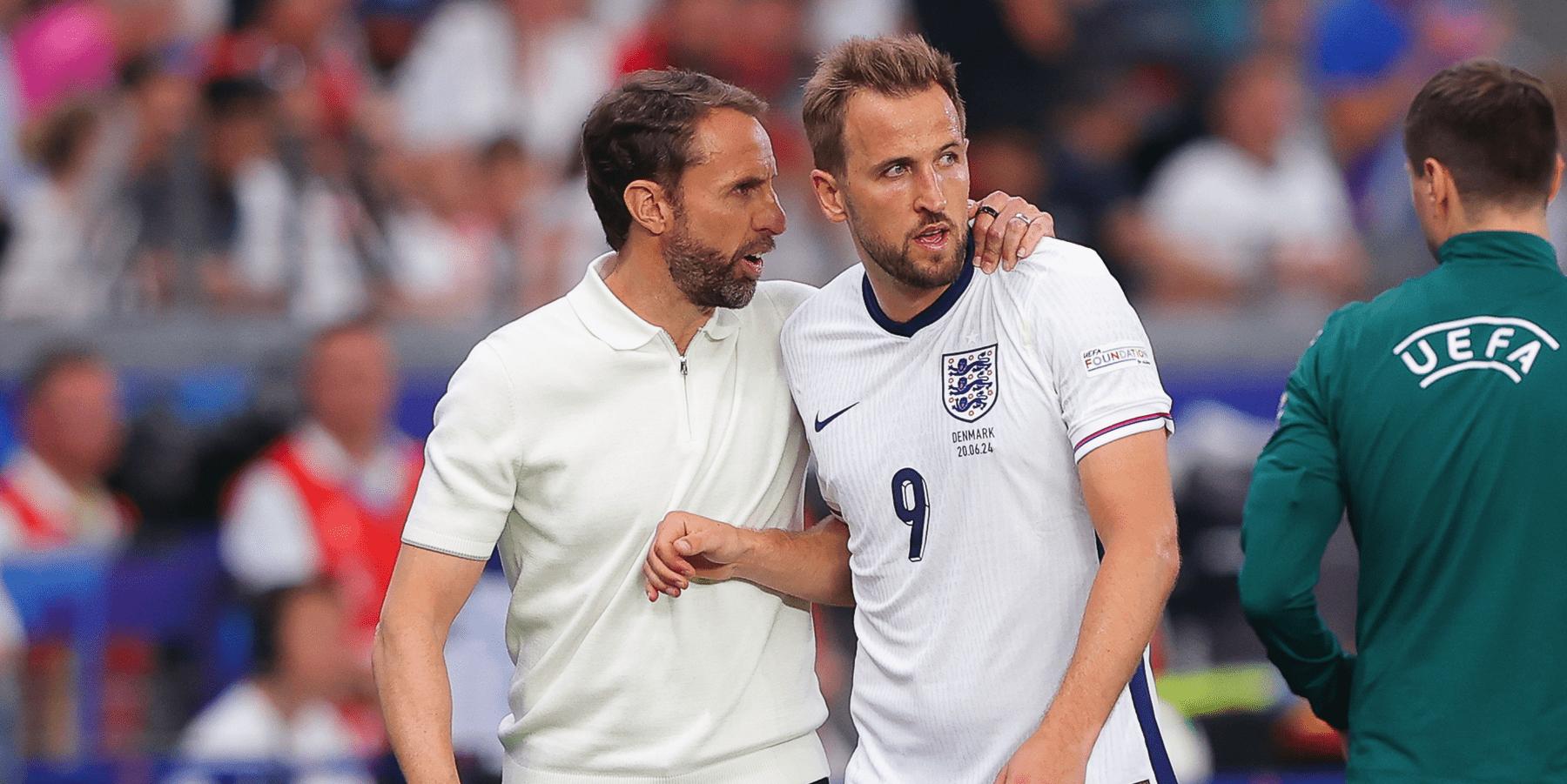England are top of their Euro 2024 group but have been far from convincing with the ball in their opening two games. So, what could change for their final group-stage match?
England’s players have publicly insisted there is no need to panic.
The woeful attacking display against Denmark might have been way off what these players are capable of producing but – they will argue – England got a draw, are still unbeaten, and are top of the Group C after two matches. One winnable game against Slovenia now remains for England to seal their progress through to the round of 16 as group winners. It could be much worse.
But it is also true that at no point during England’s first two games did they look like a team that knows how to play together, or one that will go as far as many predicted they would before the tournament started (pointing no fingers at the Opta supercomputer). At the time of writing, only eliminated Scotland (0.95 xG) have produced a lower expected goals total at Euro 2024 than England (1.39).
The cold, hard truth is that Gareth Southgate is still, despite having 14 games to experiment between the 2022 World Cup and the start of Euro 2024, well, experimenting with his lineup.
And after two below-par performances at this summer’s tournament, the assumption is that he will tinker with his team for Tuesday’s Slovenia match as he tries to find a more coherent attacking solution.
Reports on Monday suggested Conor Gallagher will replace Trent Alexander-Arnold in midfield, while Luke Shaw was recently confirmed as out by Southgate, but what else could he change? Here are five options to fix England’s underperforming attack.
A More Natural Option on the Left
England’s left side has been a major problem. Playing a right-footed right-back at left-back in Kieran Trippier was always going to limit how the ball would progress down that flank, but also selecting Phil Foden on the left side of midfield when he doesn’t want to stay wide and has also quite clearly been instructed not to, has meant England have carried next to no attacking threat on that side. Against Denmark, England had 44.4% of their attacking touches down their right, compared to just 23.2% on the left.
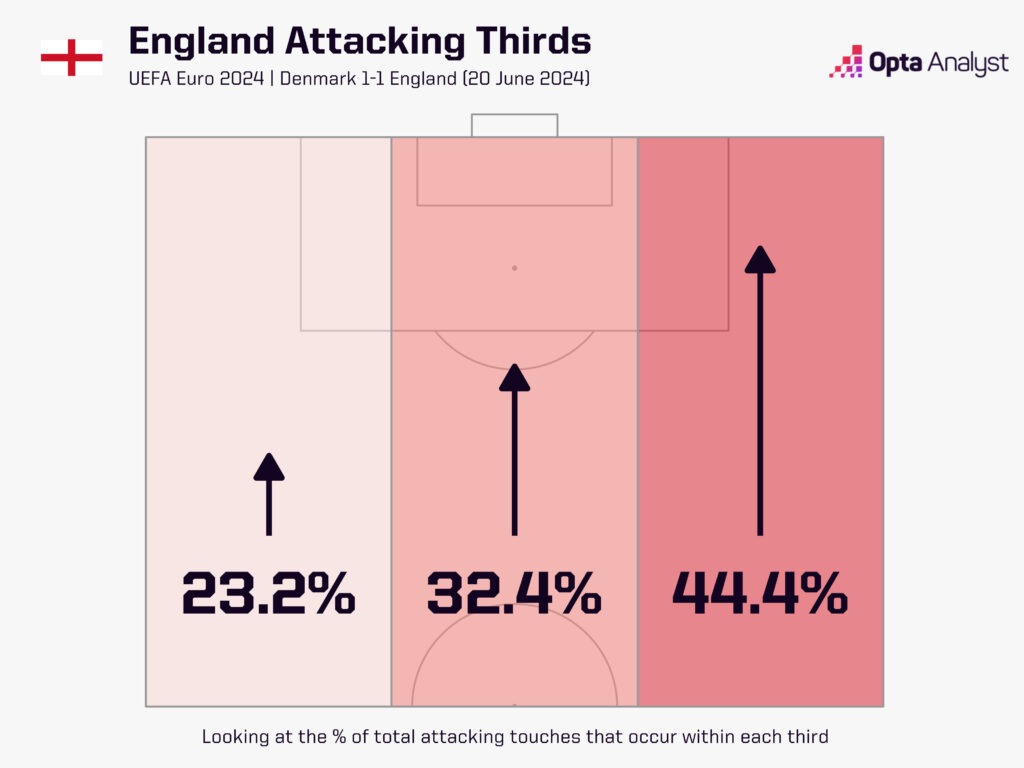
So, the simplest and most obvious option is to put a player who is used to playing on the left… erm… on the left.
Given Southgate chose to leave Jack Grealish and Marcus Rashford at home, the only natural left-sided attacker he has in his squad is Anthony Gordon. There have been plenty of calls for the Newcastle winger to be given a chance, but with just three caps to his name and given the curious decision from Southgate to introduce Eberechi Eze there against Denmark instead, throwing Gordon in would represent a big risk.
He would at least provide natural width, direct running and a potential threat in behind the opposition that England have so far been decidedly lacking. His ball retention is far worse than Foden’s so England might lose the ball more with him in the team, but there is an argument that him stretching the opposition would create so much space that he is worth including.
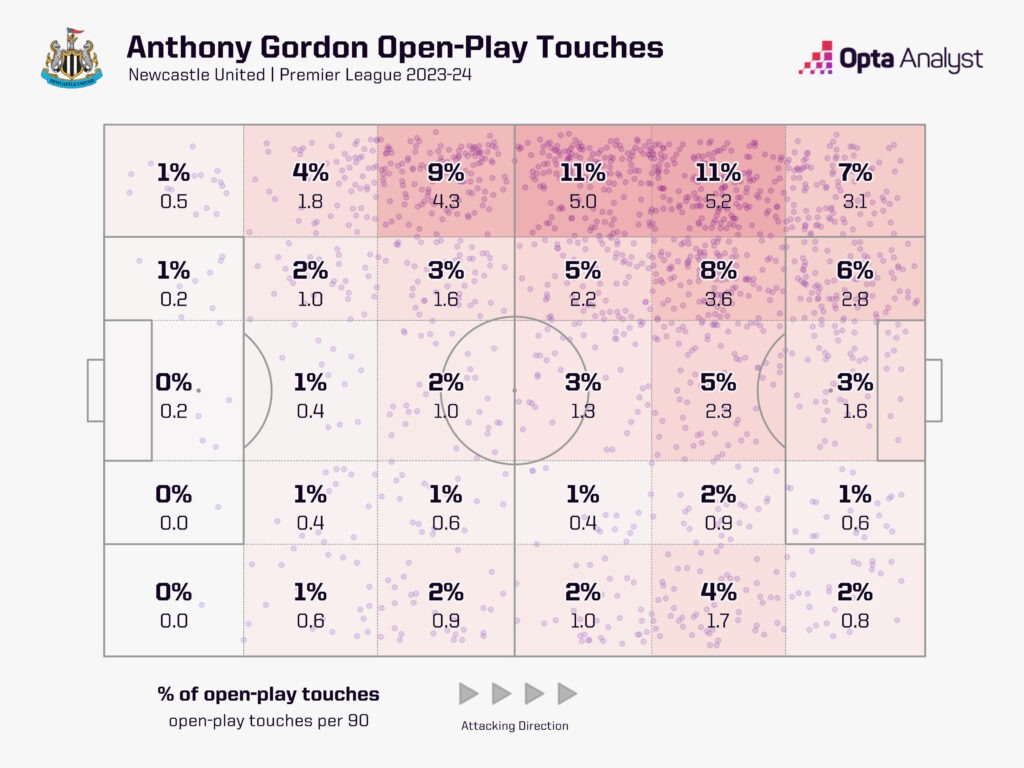
Having a player of Foden’s ability on the bench might be unthinkable to some, but the team could benefit from having fewer square pegs in round holes, and playing Gordon on the left would at least solve that issue.
Bring in a Proper ‘Phillips’ Replacement
Southgate’s thinking in playing Foden on the left is clearly centred around the idea that the Manchester City star, who registered 39 goal involvements (27 goals, 12 assists) in 53 appearances for his club last season, just has to be in the team.
After a quiet display against Serbia, Foden was far more involved against Denmark, leading the way for England for shots (four) and dribbles (four – level with Jude Bellingham), and coming closest to adding a second goal when he hit the post in the second half.
The England manager will presumably be reluctant to leave a player of Foden’s ability out, and his decision to hook Alexander-Arnold on 53 minutes – a quarter of an hour before Foden, Harry Kane and Bukayo Saka were taken off – suggests Southgate might see central midfield as a bigger issue.
The Alexander-Arnold “experiment”, as Southgate called it, hasn’t worked. This is his last chance to accept that fact and play an actual central midfielder in central midfield. As mentioned, it appears Gallagher might be the one to come in.
But Southgate moaned to the media after the Denmark game that England “don’t have a natural replacement for Kalvin Phillips.” It’s a remark that has annoyed as many people as it has bemused given both how long Southgate has had to find a solution to that particular problem and also the fact that he chose to pick Crystal Palace’s excellent ball-playing central midfielder Adam Wharton in his squad – but hasn’t yet given him a minute at the Euros. Wharton is far more of a Phillips replacement than Gallagher.
England struggled to play through midfield against Denmark, with Declan Rice particularly cautious on the ball. Gallagher’s introduction did not fix that issue.
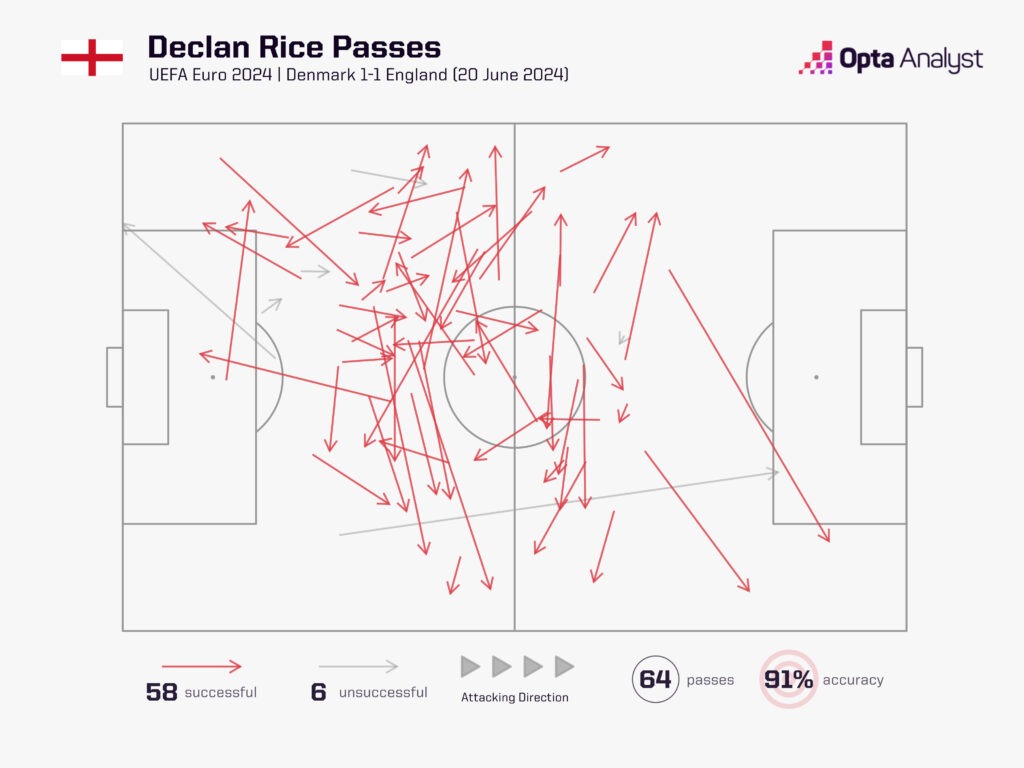
Wharton’s presence would give England more balance in the middle of the park, and would also help them play through the lines more fluently. That could mean finding Kane’s feet more easily, but also increase the chances of getting Foden or Bellingham on the ball centrally between the lines more often. Maybe, then, England wouldn’t need width down the left side as much, or at least they wouldn’t feel the absence of it quite so badly.
Change to Three at the Back
It’s worked for England at other tournaments, so perhaps a change of shape is the best bet?
While England don’t have an obvious option at left wing-back, this solution would, at least, mean that there is only one role where someone is playing out of position, rather than both at left-back and left midfield, as is the case in Southgate’s 4-3-3.
Trippier is the most obvious choice at left wing-back until Luke Shaw is fully fit, and Alexander-Arnold could keep his spot in the team – at right wing-back – while Kyle Walker would make up a back three with John Stones and Marc Guehi.
But adding an extra defender means either a two-man central midfield – which would likely mean Bellingham playing deeper and with less attacking threat – or one fewer player in attack, which would mean one of Foden or Saka dropping out.
Another alternative would be playing Saka at left wing-back. He has played there before both at club and international level, but not for a very long time, and he has become one the world’s best right wingers in the last couple of years.
In an admittedly weak field, Saka has been up there as one of England’s most dangerous attacking players so far at the Euros. Only Bellingham (six) has completed more dribbles than him (five), while he has also made more carries of at least 10 metres towards the opposition’s goal (10) than any other teammate.
He is also one of only two England players alongside Alexander-Arnold (three) to have created more than one chance (two). Moving him into a defensive position makes little sense.
What’s more, England haven’t started a game with a back three since facing Germany in September 2022 – 22 matches ago. There aren’t many in the squad who play with three at the back at club level, either.
On second thoughts, does changing to three at the back actually create more problems than it solves?
Choose Players Who Can Press
From the evidence of their first two Euro 2024 games, it’s safe to say England are either not very good at pressing or not a team who want to press. The only team averaging more passes per defensive action (PPDA) than England (23.1) so far at the tournament is Albania (24.4), who have also faced sterner tests in Italy, Croatia and Spain.
Meanwhile, only the Netherlands and Georgia (six each) have won the ball within 40m of the opposition’s goal on fewer occasions than England (eight). None of England’s high turnovers have come close to goal, and only one has resulted in a shot.
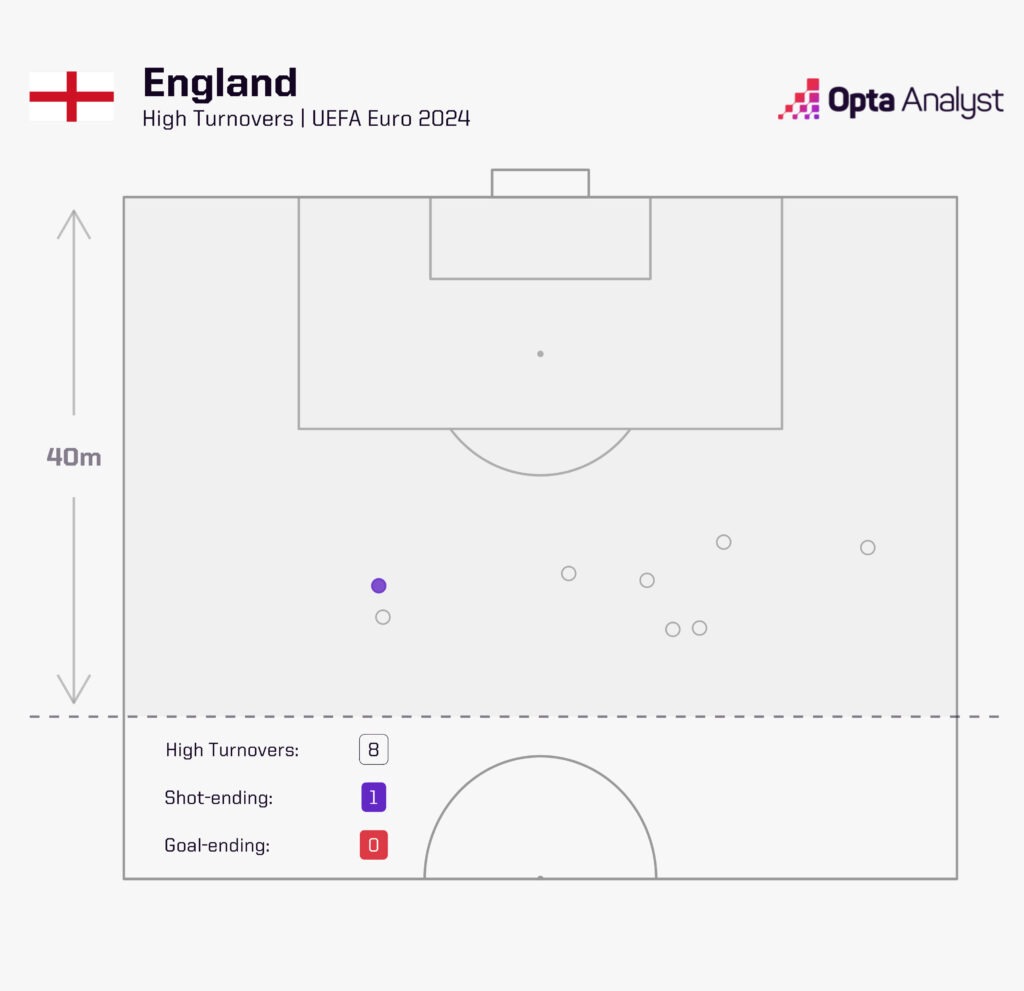
The first thing to say is that this is a very small sample size, and no international team is ever going to be able to press in as coordinated and effective a manner as a club team given how infrequently they play or train together.
But England have barely pressed at Euro 2024 and when they have they have done so poorly. There have been calls to replace Kane with a more mobile striker to help defend on the front foot more effectively, with the idea that a more intense press would help create more goalscoring chances.
Ollie Watkins is the obvious choice there but his ineffective substitute appearance against the Danes may have harmed his chances of starting. He did make a smart run in on goal shortly after coming on and forced Kasper Schmeichel into a save with his effort, but otherwise he barely contributed anything. He touched the ball only six times and failed to complete a single pass. With Watkins at the tip of a new and unfamiliar front-three combination, England looked no more able to press effectively, either.
There is, in reality, very, very little chance of Southgate dropping captain Kane, but that won’t stop some people from calling for it to happen.
Risk Shaw
Given Southgate’s most recent comments ahead of England’s final group game, it seems that Luke Shaw isn’t ready to feature yet. But as England progress deeper in the tournament, the question of when it is “time” to risk Shaw will only grow more pertinent.
One of the most frustrating aspects about England’s Euro 2024 displays is that they would have much more balance if they had a left-footed left-back who could overlap around the outside of Foden, stretch the pitch and at the very least give opponents the impression that England might consider attacking down the left.
That’s why Southgate risked including Shaw – who hasn’t played any first-team football since February – in his squad, and is giving the Manchester United left-back as long as he possibly can to recover and play a role at the tournament.
The frustration comes in the fact that there is no alternative in the squad. Shaw has a long history of injury problems, so relying on him to play in such an intense environment, with games coming every few days, always seemed like a big risk. Don’t get us started on whether Southgate should have included Tyrick Mitchell in the squad.
Presumably Southgate is prepared to play Shaw at some point, why else would he have taken him in the squad? Once we get into the knockout stages, if there’s any chance Shaw can play, it could be a risk worth taking. The idea of watching Trippier cut back and pass the ball inside for another minute – let alone another 90 – is one that many fans can’t face.
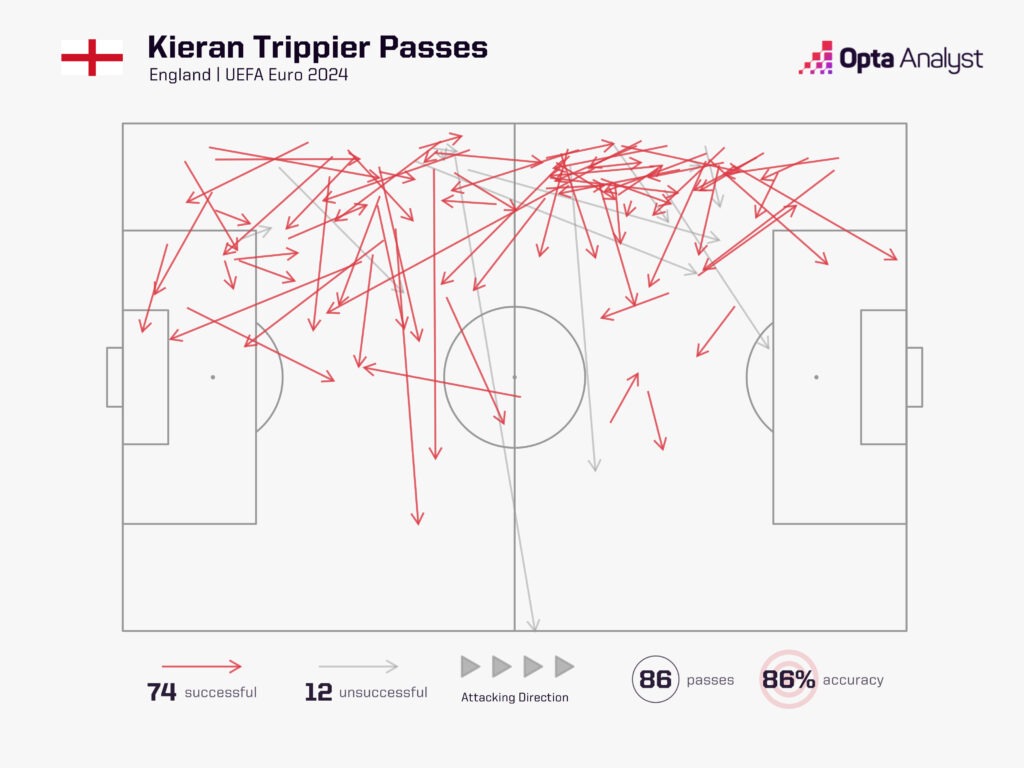
It’s not as though England need a marauding 2010s full-back who will hit the byline and whip in cross after cross. They just need some kind of attacking impetus from that part of the pitch; just anything to give opponents something else to think about.
It’s hard to imagine Trippier arriving in the penalty area like Shaw did to score England’s goal in the Euro 2020 final, for example. It’s not his fault; he just isn’t completely comfortable at left-back because, well, he’s not a left-back.
Getting Shaw in there could make a big difference. How long he’d last is another issue entirely.
Our football newsletter ‘Stat, Viz, Quiz’ is going all in on Euro 2024 this summer, so sign up to receive exclusive content. You should also follow our social accounts over on X, Instagram, TikTok and Facebook.
